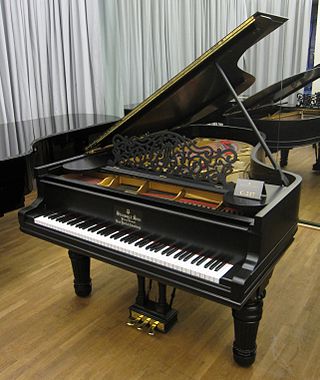
A piano is a keyboard instrument that produces sound when its keys are depressed, activating an action mechanism where hammers strike strings. Modern pianos have a row of 88 black and white keys, tuned to a chromatic scale in equal temperament. A musician who specializes in piano is called a pianist.

A keyboard instrument is a musical instrument played using a keyboard, a row of levers that are pressed by the fingers. The most common of these are the piano, organ, and various electronic keyboards, including synthesizers and digital pianos. Other keyboard instruments include celestas, which are struck idiophones operated by a keyboard, and carillons, which are usually housed in bell towers or belfries of churches or municipal buildings.

The celesta or celeste, also called a bell-piano, is a struck idiophone operated by a keyboard. It looks similar to an upright piano, albeit with smaller keys and a much smaller cabinet, or a large wooden music box (three-octave). The keys connect to hammers that strike a graduated set of metal plates or bars suspended over wooden resonators. Four- or five-octave models usually have a damper pedal that sustains or damps the sound. The three-octave instruments do not have a pedal because of their small "table-top" design. One of the best-known works that uses the celesta is Pyotr Ilyich Tchaikovsky's "Dance of the Sugar Plum Fairy" from The Nutcracker.
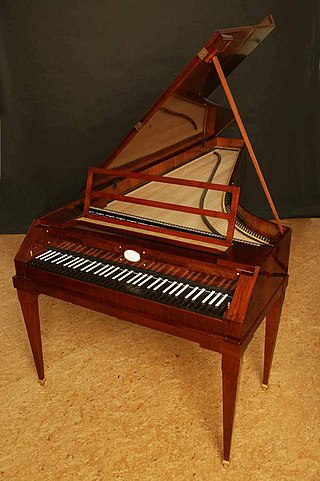
A fortepiano is an early piano. In principle, the word "fortepiano" can designate any piano dating from the invention of the instrument by Bartolomeo Cristofori in 1700 up to the early 19th century. Most typically, however, it is used to refer to the mid-18th to early-19th century instruments, for which composers of the Classical era, such as Haydn, Mozart, and the younger Beethoven, wrote their piano music.

The pump organ or reed organ is a type of organ using free-reeds that generates sound as air flows past the free-reeds, the vibrating pieces of thin metal in a frame. Specific types of pump organs include the harmonium using pressure system, suction reed organ using vacuum system, and the Indian harmonium; the historical types include the Kunstharmonium and the American reed organ; the earliest types include the physharmonica and the seraphine. The idea for the free reed was derived from the Chinese sheng through Russia after 1750, and the first Western free-reed instrument was made in 1780 in Denmark.

Johann (Georg) Andreas Stein was an outstanding German maker of keyboard instruments, a central figure in the history of the piano.

John Broadwood & Sons is an English piano manufacturer, founded in 1728 by Burkat Shudi and continued after his death in 1773 by John Broadwood.

Gottfried Silbermann was a German builder of keyboard instruments. He built harpsichords, clavichords, organs, and fortepianos; his modern reputation rests mainly on the latter two.

Sébastien Érard was a French instrument maker who specialised in the production of pianos and harps, developing the capacities of both instruments and pioneering the modern piano.
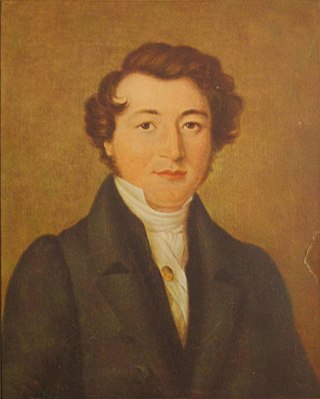
Christian Friedrich Ludwig Buschmann was a German musical instrument maker and inventor, often credited with inventing the harmonica and also the accordion.

Schweighofer was a piano manufacturer from Vienna, Austria.
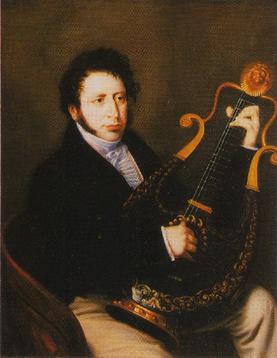
Robert Wornum (1780–1852) was a piano maker working in London during the first half of the 19th century. He is best known for introducing small cottage and oblique uprights and an action considered to be the predecessor of the modern upright action which was used in Europe through the early 20th century. His piano manufacturing business eventually became Robert Wornum & Sons and continued half a century after his death.
The keyboard glockenspiel (French: jeu de timbre) or organ glockenspiel is an instrument consisting of a glockenspiel operated by a piano keyboard. It was first used by George Frideric Handel in the oratorio Saul (1739). It was also used in the 1739 revivals of his Il Trionfo del Tempo and Acis and Galatea, and the next year in L'Allegro, il Penseroso ed il Moderato. Half a century later, Wolfgang Amadeus Mozart employed a strumento d'acciaio in The Magic Flute (1791) to represent Papageno's magic bells, and this instrument is believed to have been a keyboard glockenspiel. This part is nowadays sometimes taken by a celesta. Maurice Ravel preferred the keyboard version of the instrument because it can play a true ff dynamic for brilliance and iridescence in orchestral climaxes. In the late 20th century, the firm of Bergerault began manufacturing a three-octave (F2–E4) mallet instrument with a damping mechanism operated by a foot pedal, which is capable of dealing with the wide range called for in contemporary scores.
Karl Friedrich Schall was a German precision engineer and co-founder of the company Reiniger, Gebbert & Schall (RGS) in Erlangen. RGS was a manufacturer and supplier of durable medical equipment and a pioneer in the supply of x-ray equipment worldwide with offices in Berlin, Wien, London, Paris, Rome, Chicago and Sydney.

Johann Lorenz Schiedmayer was a German piano maker.
W. Ritmüller & Sohn AG was a piano manufacturer originated in Göttingen, Germany.
Carl Dieudonné was a co-founder of Dieudonné & Schiedmayer, a firm in Stuttgart that built pianos. He founded the firm together with Johann Lorenz Schiedmayer, and the Schiedmayer firm continued to build pianos well into the 20th century.
Sauter Pianofortemanufaktur GmbH & Co KG is a German piano manufacturer in Spaichingen, Baden-Württemberg.
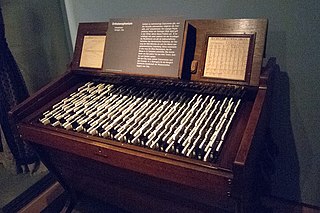
The Orthotonophonium is a free reed aerophone similar to a Harmonium with 72 keys per octave, that can be played all diatonic key intervals and chords using just intonation. The instrument was created in 1914 by German physicist Arthur von Oettingen to advance his theories of harmonic dualism.





















